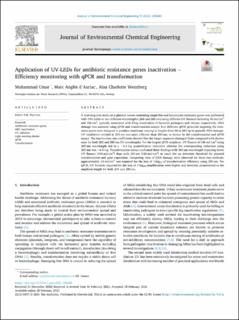| dc.contributor.author | Umar, Muhammad | |
| dc.contributor.author | Anglès d'Auriac, Marc | |
| dc.contributor.author | Wennberg, Aina Charlotte | |
| dc.date.accessioned | 2021-07-23T07:26:12Z | |
| dc.date.available | 2021-07-23T07:26:12Z | |
| dc.date.created | 2021-07-20T13:50:52Z | |
| dc.date.issued | 2021 | |
| dc.identifier.citation | Journal of Environmental Chemical Engineering. 2021, 9, 105260. | en_US |
| dc.identifier.issn | 2213-3437 | |
| dc.identifier.uri | https://hdl.handle.net/11250/2765155 | |
| dc.description.abstract | A dose-response study on a plasmid vector containing ampicillin and kanamycin resistance genes was performed with UVC-LEDs at two different wavelengths (265 and 285 nm) using different UV fluences including 40 mJ/cm2 and 186 cm2, typically associated with 4-log inactivation of bacterial pathogens and viruses, respectively. DNA damage was assessed using qPCR and transformation assays: four different qPCR protocols targeting the resistance genes were designed to produce amplicons varying in lengths from 80 to 601 bp to quantify DNA damage. UV irradiation emitted at 265 nm was more efficient than 285 nm, as shown by the transformation and qPCR assays. The inactivation rate coefficients showed that the longer segments damaged faster compared with shorter ones for both 265 and 285 nm UV wavelengths. For the largest qPCR amplicon, UV fluence of 186 mJ/cm2 using 285 nm wavelength led to a ~4.2-log quantification reduction whereas the corresponding reduction using 265 nm was ~6.5-log. Transformation assays confirmed these findings with 265 nm wavelength requiring lower UV fluence (100 mJ/cm2) than with 285 nm (186 mJ/cm2) to reach the no detection threshold for plasmid transformation and gene expression. Comparing rates of DNA damage were observed for these two methods; approximately 24 mJ/cm2 was required for the loss of 1-log10 of transformation efficiency using 285 nm. For qPCR, UV fluences required for the loss of 1-log10 amplification were higher and inversely proportional to the amplicon length for both 265 and 285 nm. | en_US |
| dc.language.iso | eng | en_US |
| dc.publisher | Elsevier | en_US |
| dc.rights | Navngivelse 4.0 Internasjonal | * |
| dc.rights.uri | http://creativecommons.org/licenses/by/4.0/deed.no | * |
| dc.title | Application of UV-LEDs for antibiotic resistance genes inactivation – Efficiency monitoring with qPCR and transformation | en_US |
| dc.type | Peer reviewed | en_US |
| dc.type | Journal article | en_US |
| dc.description.version | publishedVersion | en_US |
| dc.rights.holder | © 2021 The Author(s). | en_US |
| dc.source.pagenumber | 9 | en_US |
| dc.source.volume | 9 | en_US |
| dc.source.journal | Journal of Environmental Chemical Engineering | en_US |
| dc.identifier.doi | 10.1016/j.jece.2021.105260 | |
| dc.identifier.cristin | 1922252 | |
| dc.relation.project | Norges forskningsråd: 160016 | en_US |
| dc.source.articlenumber | 105260 | en_US |
| cristin.ispublished | true | |
| cristin.fulltext | original | |
| cristin.qualitycode | 1 | |

